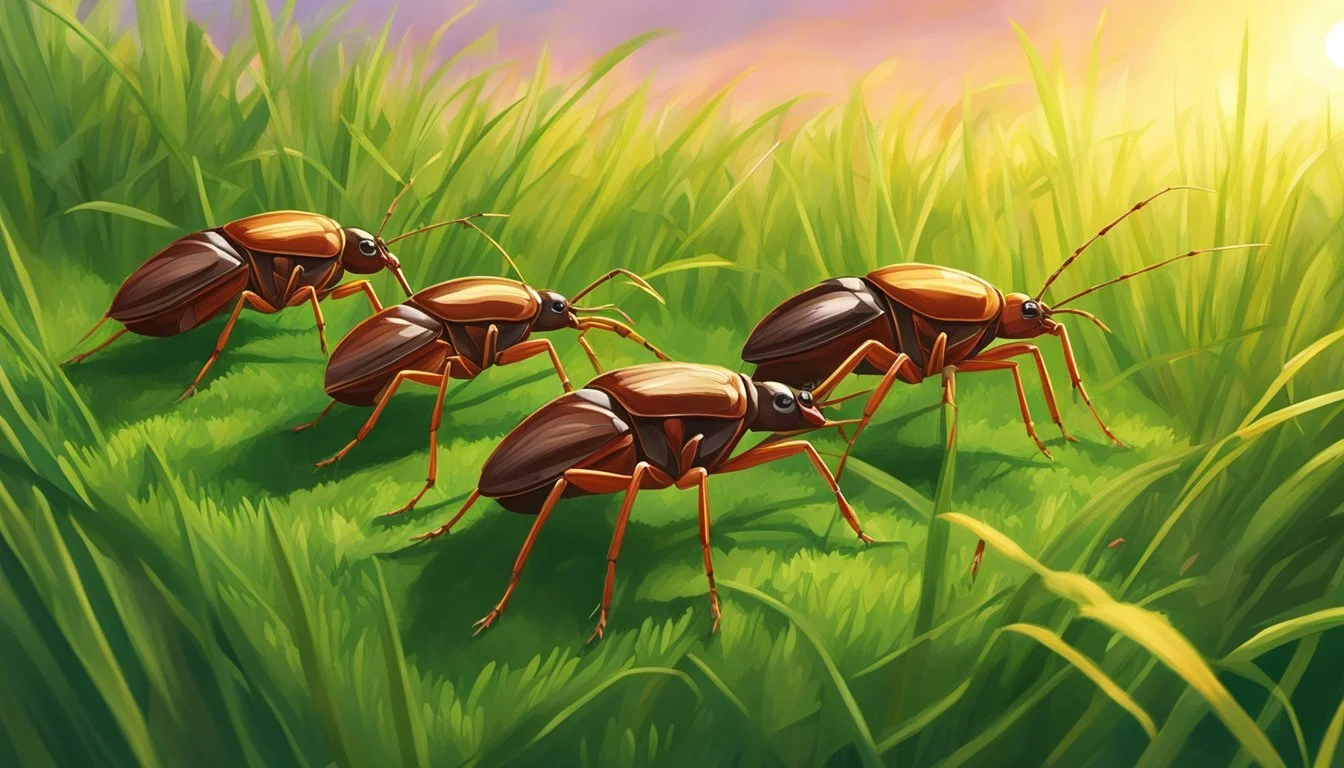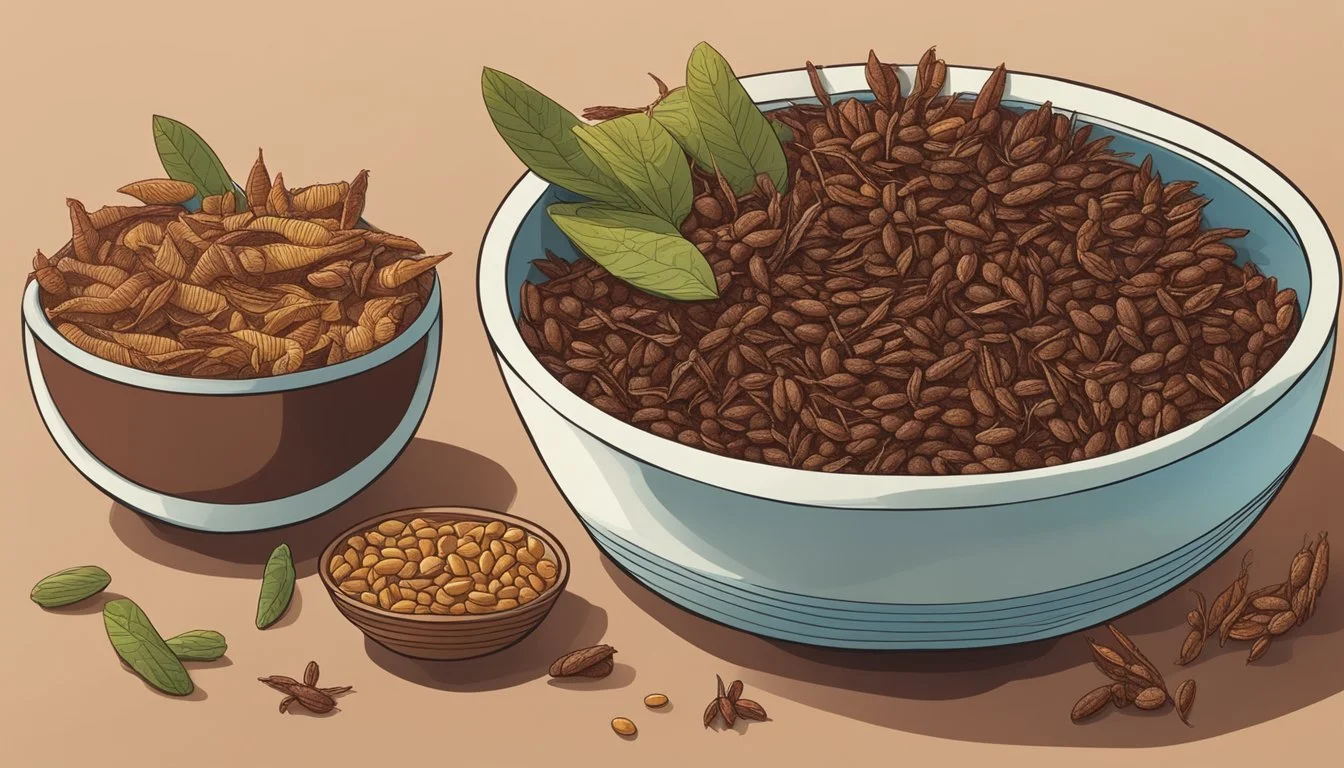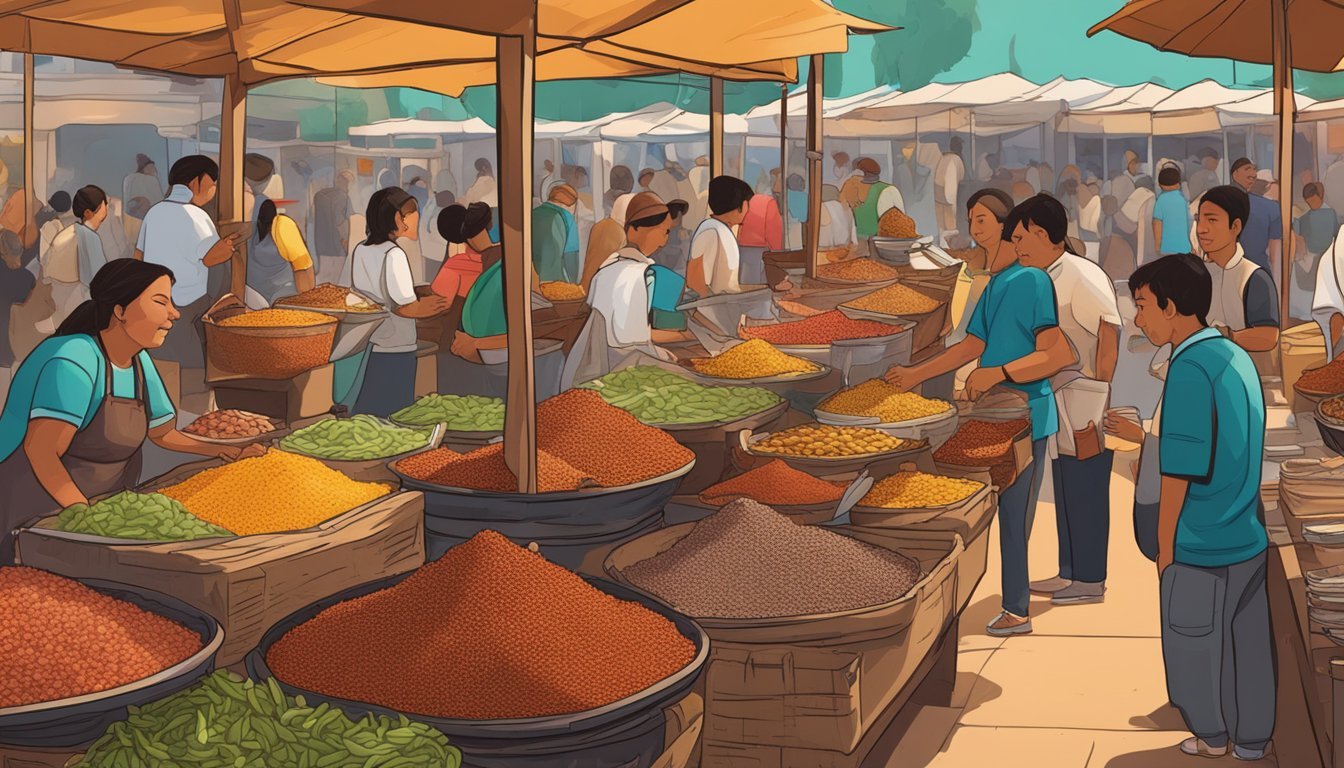Chapulines The Edible Grasshoppers Elevating Mexican Cuisine
Chapulines, or edible grasshoppers, have been a significant element of Mexican cuisine for centuries, particularly in regions like Oaxaca, where they are not only a culinary delight but also an integral part of the cultural heritage. These insects, primarily harvested from fields of alfalfa or corn, are an environmentally sustainable source of protein. They are commonly prepared by toasting and seasoning with a mixture that often includes garlic, lime juice, and chiles, resulting in a crunchy texture and a flavor that combines earthy notes with a citrusy sharpness.
The culinary practice of incorporating chapulines into meals showcases the innovative use of natural resources by local cooks in Mexico. Far from being a novelty, the consumption of these grasshoppers reflects a deep appreciation for the diverse ingredients available in the region. The grasshoppers are served in various ways: as a standalone snack, a filling for tacos, or a topping on tostadas, often accompanied by avocado or salsa to balance the robust flavors.
Due to their high protein content and distinctive taste, chapulines continue to captivate food enthusiasts around the world, introducing the uninitiated to the delights of traditional Mexican gastronomy. While to some the idea of eating insects may seem unorthodox, for many Mexicans, chapulines remain a proud emblem of their rich and varied culinary landscape.
Historical Background
In the rich tapestry of Mexican cuisine, chapulines stand out as a testament to the culinary heritage that dates back to pre-Columbian times. They illustrate a food source that link modern practices to indigenous traditions.
Pre-Hispanic Significance
In pre-Hispanic Mexico, the consumption of insects was a common practice among various indigenous groups, including the Zapotec civilization. Chapulines, specifically, served as a significant source of protein and nutrients. They were highly esteemed in the diets of these communities, owing to their abundance and the ease with which they could be harvested. The practice of consuming chapulines is thought to have been especially prevalent among the inhabitants of the Valley of Oaxaca, where the Zapotecs built an intricate society well before the arrival of the Spanish.
Cultural Evolution
Post the Spanish conquest, many pre-Columbian traditions underwent transformations or faded; however, the culinary tradition of eating chapulines persisted. This can be attributed to their enduring cultural significance and nutritional value. As the years progressed, chapulines became integrated into the broader spectrum of Mexican gastronomy. They transitioned from a rudimentary food item to a delicacy that represents the fusion of Mexico’s complex history and its rich indigenous heritage. Today, they are not only a link to Mexico's past but also a cherished part of its present, reflecting the resilience and adaptability of traditional Mexican food (What wine goes well with Mexican food?) practices.
Nutritional Profile
Chapulines, or grasshoppers, are not only a traditional delicacy in Mexican cuisine but also a nutritious food source rich in protein and various essential minerals.
Protein Content
Chapulines provide a high level of protein, which is vital for muscle repair, enzymatic functions, and overall bodily health. They contain approximately 60% to 70% protein by dry weight, making them a comparable protein source to beef and chicken.
Vitamins and Minerals
Chapulines are a good source of important vitamins and minerals. They provide a significant amount of iron and zinc, two minerals essential for immune function and metabolism. Additionally, they contain fiber, which is beneficial for digestive health. Typically, chapulines also have a favorable ratio of unsaturated to saturated fats.
Mineral: Iron
Importance: Crucial for oxygen transport and DNA synthesis
Mineral: Zinc
Importance: Supports immune system and wound healing
Mineral: Fiber
Importance: Aids in digestion and can help control appetite
Furthermore, their fat content is predominantly unsaturated, contributing to a healthier lipid profile for consumers.
Culinary Uses
Chapulines, or edible grasshoppers, hold a significant place in Mexican cuisine, particularly for their versatility as both a snack and an ingredient. They are renowned for their distinct earthy flavor profile and are used in various traditional and modern dishes.
Traditional Dishes
In traditional Oaxaca cuisine, chapulines are often found as a snack, either on their own or as part of a larger meal. They are typically seasoned with a blend of chili, salt, and lime juice to enhance their natural, umami-rich flavor. One notable dish is tlayuda, a large toasted corn tortilla topped with beans, cheese, and a generous sprinkling of chapulines, creating a mix of textures and rich flavors.
Another common use for chapulines is in tacos, where they provide a crunchy texture and are usually paired with fresh guacamole, onions, and corn tortillas. They also make a flavorful garnish for salads and can be incorporated into mole sauces to add depth of flavor and a touch of novelty.
Modern Incorporations
Chefs in Mexico and beyond have been experimenting with chapulines, integrating them into a multitude of modern culinary applications.
In the United States, they've made appearances in eclectic restaurant menus, especially in cities like Los Angeles. Here, chapulines are not only a novelty but also an introduction to authentic Mexican flavors. They are served roasted and seasoned, ready to excite the palate as an exotic and protein-rich delicacy.
Chapulines are also gaining ground as a unique and sustainable protein alternative. Their nutty and crunchy texture is used to complement the creamy texture of guacamole or as a contrasting element in salad toppings. As a garnish, chapulines add a surprising element to otherwise familiar dishes.
Flavors and Preparation
The flavors of chapulines are deeply rooted in the traditional spices and cooking methods of Mexico. Capturing a yeasty and crunchy texture, the preparation process enhances the insect's natural taste with a variety of seasonings and spices.
Seasoning and Spice
Chapulines are renowned for their unique blend of flavors, achieved by a careful selection of seasonings. Essential to their seasoning is:
Salt
Garlic; finely chopped or in powder form.
Lime Juice; freshly squeezed to add a citrus kick.
The combination of these ingredients, along with local spices such as dried chili, imparts a distinctive savory taste with a hint of spiciness and acidity, complementing the chapulines' inherent nutty flavor.
Cooking Techniques
The cooking of chapulines is straightforward yet skillful, ensuring the insects retain their crunchy texture:
Roasting or frying in oil:
Roasting brings out a nuttier taste, while frying provides an extra level of crispness.
The removal of wings and legs before cooking for a better texture.
Quick cooking, traditionally done in a shallow pan over medium-high heat, until achieving the desired crunch.
Onions may be sautéed with the chapulines and discarded after imparting their flavor, leaving a pure, unadulterated taste of the insects seasoned to perfection.
Cultural Context
In the tapestry of Mexican cuisine, chapulines stand out as a traditional food deeply interwoven with the cultural fabric of Oaxaca. They are not only a popular street food but also a symbol of hospitality in the home.
Festivals and Street Food
During festivals, such as the Guelaguetza, which is a celebration of culture and diversity in Oaxaca, chapulines become a ubiquitous sight. Vendors at markets and street corners in Oaxaca City offer these crispy treats, seasoned primarily with chili, garlic, and a spritz of lime juice. Tourists and locals alike can often be found enjoying chapulines as an on-the-go snack, indicative of the region's street food culture.
Home Cooking and Hospitality
The role of chapulines in home cooking exemplifies the hospitality intrinsic to Oaxacan culture. They are offered to guests as a sign of welcome and are commonly incorporated into meals within family settings. In many Oaxacan homes, chapulines are a staple, and their preparation can vary from being a simple snack to being a featured ingredient in complex dishes. This culinary tradition extends a unique sense of warmth and generosity to all who partake in the experience.
Environmental Benefits
Chapulines offer notable environmental advantages that echo the growing need for sustainable food sources.
Sustainability
Chapulines consume far less water and feed compared to traditional livestock, translating into a smaller ecological footprint. Eating chapulines is a sustainable choice as insects in general are more efficient at converting feed into protein, requiring less land for production. This promotes biodiversity and aids in preserving natural landscapes.
Seasonal Harvesting
They are typically harvested during the rainy season, when their populations peak. This aligns their gathering with natural growth cycles, avoiding the year-round strain on resources imposed by conventional agriculture. This seasonal method reduces the need for artificial inputs and supports the sustainability of the practice.
Regional Variations
Chapulines are a traditional Mexican cuisine with variations that reflect local flavors and cultural practices, particularly centered in Oaxaca and interpreted globally.
Oaxaca as a Hub
In Oaxaca, the consumption of chapulines is steeped in a rich tradition, with Oaxaca City serving as a bustling marketplace for this delicacy. Here, chapulines are often seasoned with garlic, chili, and lime juice, offering a unique taste profile that doubles as a staple snack and a versatile culinary ingredient. Oaxaca's chapulines might also accompany tlayudas, large corn tortillas slathered with asiento, beans, lettuce, avocado, meat, and cheese, which serve as a hearty canvas for the crispy grasshoppers.
International Comparisons
While the practice of eating insects may seem novel to some cultures, chapulines are part of a broader spectrum of edible insects enjoyed around the world. In Thailand, for instance, grasshoppers are also fried and flavored with local spices, serving as a common street food. Meanwhile, in Uganda, grasshoppers, locally known as 'nsenene', are considered a delicacy and are typically pan-fried or boiled. Although the preparation methods and spices differ, these international variations highlight a global recognition of insects as a viable and sustainable source of protein.
Comparison to Other Snacks
Chapulines provide a distinctive crunch and flavor profile that sets them apart from mainstream snacks. They offer a culinary adventure that incorporates traditional Mexican culture into the snacking experience.
Texture and Taste Profiles
Chapulines have a crunchy texture akin to popular snacks such as potato chips, yet they are distinguished by their unique taste combinations. Unlike the widespread salt and vinegar potato chips, chapulines are typically seasoned with a mix of chili powders, garlic, and lime juice, offering a complex, savory, and slightly tangy flavor. Their texture might remind one of the crispiness of fried chicken skin but with a lighter bite, appealing to those who appreciate a crunchy snack with an unconventional flavor twist.
While potato chips offer a satisfying crunch, chapulines' protein content couples that desired texture with nutritive value, aligning more closely with those seeking both taste and health benefits in their snacks.
Global Snack Market
Chapulines are gradually gaining traction in the global snack market. In Seattle, fans attending Seattle Mariners baseball games have the unique opportunity to sample chapulines, reflecting a growing trend of incorporating ethnic and gourmet options into mainstream snacking venues.
Snack Type: Potato Chips
Origin: Global
Texture: Crunchy
Flavor Profile: Varied, salty
Mainstream Availability: High
Snack Type: Chapulines
Origin: Mexico
Texture: Crunchy
Flavor Profile: Savory, citrusy, spicy
Mainstream Availability: Emerging
This table illustrates the contrast between chapulines and potato chips, highlighting the novelty and growing acceptance of traditional foods in the snack industry. The crunchy insects are not just a cultural delicacy but are becoming part of a wider movement towards diversifying snack choices worldwide.
Future of Edible Insects
The integration of edible insects into global diets is on the rise, reflecting a trend towards sustainability and nutritional innovation. Here's how the future looks for entomophagy, the practice of eating insects, and its market expansion.
Entomophagy Worldwide
Entomophagy is practiced in many cultures around the world, with a prominent presence in Mexican cuisine where chapulines, or grasshoppers, are a traditional delicacy. This practice has gained interest in Western societies, particularly in cities like Los Angeles, where diverse culinary adventures are embraced. Beyond individual consumption, even sports arenas such as those hosting the Seattle Mariners have featured insects on their menus, indicating a growing acceptance of entomophagy.
Moreover, global health and environmental narratives support the increased use of edible insects, considering their high nutritional value and low ecological footprint. As such, insects are not only seen as a viable alternative protein source but are also featured in popular gastronomic guides like Zagat, underscoring their culinary potential.
Market Growth and Challenges
The market for edible insects is expanding, with a forecasted increase in both variety and accessibility. Here is a brief look at the expected trends:
Market Trends:
Growth: The edible insect market is projected to grow, with more products hitting mainstream grocery shelves and restaurant menus.
Diversification: Expect to see an increase in the types of insects offered, such as mealworms and crickets, in various forms from whole to powdered.
Barriers:
Cultural Acceptance: Convincing consumers to overcome the 'yuck factor' remains a significant hurdle.
Regulation: The regulatory landscape for the production and sale of edible insects still needs to be standardized and streamlined.
The industry faces challenges related to consumer perception and regulatory approval. The novelty of insect-based foods in Western markets means that companies must work to normalize the idea of insects as food. This involves educational campaigns and strategic marketing to shift public opinion. At the same time, developing coherent regulations that ensure safety and quality is crucial for consumer confidence and industry growth.
Conclusion
Chapulines, the seasoned grasshoppers that are an integral part of Mexican cuisine, represent not just a culinary delight but also a sustainable food source. They are particularly prominent in the region of Oaxaca but have found their place in various parts of Mexico and beyond. Their crunchy texture and distinctive flavor, enhanced by a blend of garlic, chilies, and lime, make them a versatile ingredient.
Cultural Significance
Integral to Oaxacan gastronomy
Consumed as both a snack and a complement to dishes
Carries historical importance as a protein source
Sustainability
Low ecological footprint compared to traditional livestock
Contributes to food security by offering essential nutrients
Eaten alone as a snack or used as a topping for tacos and tostadas, chapulines are as much a conversation starter as they are a testament to the innovation of Mexican cuisine. Given their sustainability, chapulines not only align with growing environmental concerns but also provide a nutrient-rich alternative to meat.
As the global culinary landscape evolves, chapulines continue to garner attention, inviting diners from all walks of life to engage with a millennia-old tradition that is both flavorful and ecologically considerate. Whether one is exploring the streets of Mexico City or enjoying fare from a Los Angeles restaurant, chapulines are a symbol of the rich tapestry that Mexican culinary arts have to offer.





